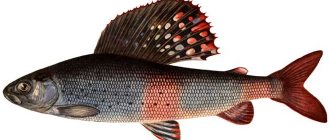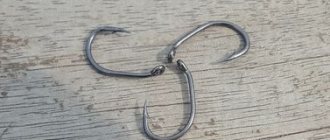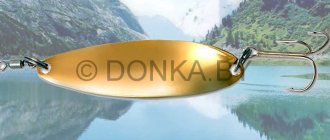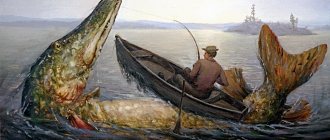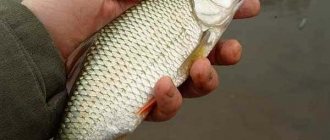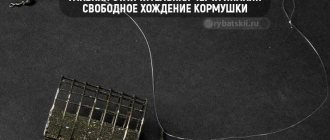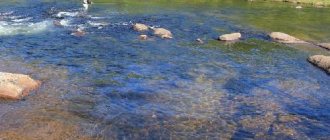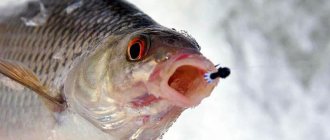Roach, who doesn’t know it! In different regions of the country it is called chebak, soroga. It belongs to the so-called trash fish, although they catch it with great pleasure. The main feature is red eyes. It is not a predator, so roach is mainly caught using bottom tackle. Spinning rods are not specifically used for fishing. But, nevertheless, it is often caught on a spinning rod, which suggests that every peaceful fish contains a hidden predator.
They catch roach in almost all reservoirs of our country, with the exception of several rivers in the northeast.
Roach on microjig
Features of life
Roach spawning depends on water temperature; it occurs in April or May, depending on the climate zone. There is no ban on roach fishing. Even during spawning, it can be caught on a spinning rod with one hook, with some exceptions. Fishing is prohibited only in those places where fishing is not permitted by law at all, for example, on the Volga near the Dubna dam.
Roach grows slowly. The most common fish weighing 100-200 grams. If your catch contains specimens weighing 400-500 grams, then such catch deserves respect, and catching a specimen weighing 1 kilogram or more is already a subject of discussion and pride.
The roach feeds in small portions, but often. It feeds both day and night, and its diet changes depending on the time of day. In the morning it bites on plant baits, in the evening – on animals. Spinning baits imitate living organisms, therefore, it is better to fish with a spinning rod in the evening hours.
Ways to play
About 90% of bites when fishing on a balda occur on the rise. On the descent, the fish take much less often. However, it happens that this rule fails, because there are days when the fish take only on the descent.
Usually the hole is fished in this way. The bait is placed on the bottom soil, “dusts” a little and goes up. The game of the mini-balda is more active than when fishing with a jig, and the rise itself is faster. During the lifting process, pauses work well when the bait stops for two to three seconds.
Read: Finding a place to catch pike on a girder
The runs between pauses in length can vary (depending on the situation), but usually there are two or three stops per meter of ascent. With a high rise from the bottom, you already stand up to your full height and move the bait upward as long as you can reach it with your hands.
Habitats
Roach fishing is carried out at the edge of the current, in places with slow currents or in standing water. Roach does not like fast currents. For example, fishing on the Volga for roach begins immediately after the river opens, in the spring. Roach feeding on the lower Volga begins at the end of April, the second peak occurs at the beginning of September.
If there is a plateau on the river, then the fish come out to feed on it at certain hours. For example, on the Volga I know a place where roaches visit every day at noon.
In June - July, using spinning rods on the Volga, according to my observations, roach fishing practically stops.
Finding a roach fishing spot
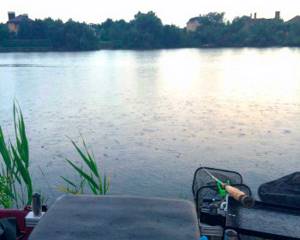
You can catch roach using float tackle all year round. In winter, you need to look for it in holes, among changes in depth, in places of underwater vegetation. With warming and the beginning of snow melting, it spins near streams of meltwater flowing into the reservoir from the shore. In the spring, she swims to the shallows, where she begins to prepare for the upcoming spawning. Immediately before it begins to spawn, it comes closer to the shore, where it looks for food among the vegetation. In summer, roach stays away from the shore, on riffles, holes, uneven surfaces, and near areas with underwater vegetation. At the beginning of autumn, it begins to gather in larger flocks and moves to the depths.
Spinning
Despite the fact that roach is classified as a “trash” fish, it is a desirable prey for many fishermen. And in the case of a bite on a spinning rod, many people wonder: “Which one?” It is also advisable to know which baits are most preferable for her.
There are no special spinning baits, such that they say “For roach” on them. But you can identify the baits that attract this fish more than others.
In the same way, there are no spinning rods for roach, but if you are fishing with ultralight, you will definitely have some catch. Fishing with spinning rods of the lightest class will not work without the participation of this fish. Even if such fishing was not the main goal.
Lures weighing up to 5 grams are used, so the weight of the spinning rod is up to 7 grams. The length should be up to 2 meters, because, most likely, you will have to lead the bait along the shore. This is due to the fact that it is difficult to place bait near the bushes, a favorite place for roaches, as there will be a large number of snags on coastal water lilies or grass.
Any fishing line - monofilament or braided, thin. Monofilament - 0.12-0.14 mm, braided - the smallest size. preferable to Japanese manufacturers, for example, Owner, Gamakatsu.
Spinning fishing for roach is interesting. Even if you are dragging a small roach, it feels like there is a decent specimen resisting at the other end of the fishing rod. You can see how this type of fishing works in the video.
Where to catch roach?
The most promising areas for roach fishing are the coastal zone and places with depths of 1.5-2 meters. In general, the main emphasis should be placed on the summer, when schools of roach actively visit shallow areas adjacent to reed thickets. It is very good to find a clean path surrounded by algae and perform careful wiring in it.
It is not necessary to make a long wiring. Often it is enough to move 4-5 meters, and you can count on a bite. In the second half of summer, anglers find it difficult to find clean areas near the shore suitable for fishing. Sometimes you have to clear the area of algae. The procedure is not as tedious as it might seem. To do this, you can use a triangle-shaped rake tied to a long string. You cast it into an area with algae and pull out the clumps of grass.
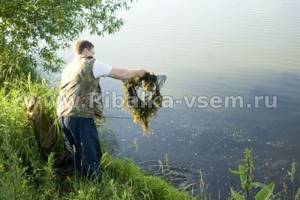
With the help of this device you will prepare for yourself a comfortable place for fishing not only with a spinning rod, but also with a bottom and float rod. In summer, a rake is a necessary accessory for a fisherman. They don't take up much space in the trunk of a car, but sometimes you can't do without them. It is especially difficult to find suitable places for fishing along the coast in August. This month marks the peak of underwater vegetation growth. Therefore, when going fishing, always take with you a rake and a rope 8-10 meters long.
Finding areas with a depth of 1.5-2 meters is very important for the other reason that it is convenient to drive turntables there. If fishing is carried out on a quiet and hot day, then you need to pay attention to small circles in the pond and splashes. When roaches are active and hungry, they often hunt for insects flying low over the water.
You should always fish where there is activity of underwater inhabitants. Where there are midges, insects, overhanging trees, a lot of fry, small and medium-sized perch, then there will definitely be roach. Areas with muddy bottoms should be avoided. As a rule, roaches do not linger on them and try to move to places with a sandy bottom, where there is enough underwater vegetation for them.
If there are no such areas, then preference should be given to snags and places with sharply changing relief. Here roaches often find shelter from predators.
Lures
Roach bites on almost any bait. But she also has some preferences.
Spoon
The roach, which has predatory tendencies, in nature chases fry. Therefore, spinners are suitable as bait; according to general opinion, they are the most common bait in the Russian Federation. The size of the spoon most likely depends on the fishing conditions.
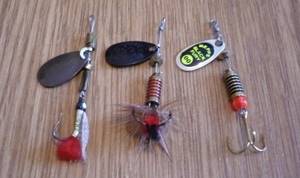
Spinner that roaches bite on
Roach is a schooling fish, but when it notices a spinner, the most active specimen of the school, it tries to try it. The fish separates from the school and swims behind the spoon. Therefore, fishing is carried out on individual individuals.
In some situations, only small spinners with three or two zeros work. On some days the roach will bite on a size 3-4 spoon, which means the fishing will be different.
- Spinner - No. 00, yellow.
- Rotary spoon - No. 3, for roach 400-500 grams.
If you are determined to catch roach, then improve your spinner bait. The roach is not a predator, its hook gripping characteristics are different, so saw off two hooks on the tee and leave one. Thus, increase the number of bites. Rotational spinners have proven themselves well: Moska Nome, Abu Garsia Bullet, Spinnex Gad Fly.
If you see a school of roach, then you should catch it “by splash”. The fish will ignore a passively falling lure. When it comes into contact with water, you need to jerk it, or the spinner itself may begin to rotate.
Fishing with small oscillating spoons will also be successful.
Jig lures
In the spring, during an active feeding season, you can catch roach using jig baits, edible silicone rubber, and bright acid colors. Edible silicone is attached to ordinary jigs.
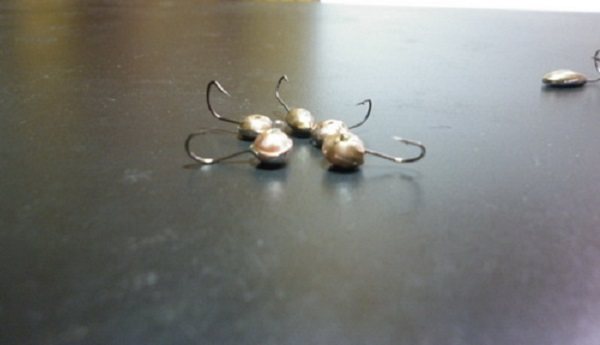
Jig for roach
Wobblers
Wobblers are even preferable to spinners. The size is very minimal, no more than 3 or 4. It has been noticed that the bite occurs when the bait is lowered, so do not lose control.
Smith IC Surger is a fast-sinking wobbler suitable for predatory and peaceful fish. Fully corresponds to the “ultralight” gear. Does not accept jerks; if tugged strongly, it can go into a tailspin. Wiring is vertical, uniform with slight trembling.
Bream on jig
I saw the first bream caught with a jig bait in October 2003. It happened on the Volga, near Mikhailovsky, on the famous Mikhailovsky Yar. The depth of the fairway drop was 15 m, the echo sounder highlighted the presence of peaceful fish, so it was quite logical to want to devote part of the short autumn day to breaking through this particular place. However, there were no bites from the predator for a long time. We were already thinking about changing the place, when suddenly someone took a “long” bite on my friend’s large yellow twister. The bites of jig fish are usually sharp and clear, but here someone simply pulled the line during a pause. It seemed like it wasn’t even a bite, but an accidental hook, the flushing of some slowly moving fish. Hooking, landing a solid trophy and now in the landing net... a bream worth more than two kilograms. It happens that when catching a predator from under a bream, the bream turns purple, but here everything was fair: the entire long tail of the twister was conscientiously swallowed by the bream, the double held the fish by the corner of its mouth. By the way, we didn’t find any pike that day, we caught a couple of medium-sized pike perch, so the bream turned out to be the most significant trophy.
The second episode with bream happened on a small Volga tributary - the Uzol River. In August 2004, my friend and I initially tried unsuccessfully to catch a chub. But the chub did not bite; the catch included several squints and perches. We decided to change the place - we moved to a deep (8 meters) Uzolsky quarry. And there, on the very first cast of the jig rig (two-inch light green twister, 4 g head) there was a rather vigorous bite. Fishing with a light spinning rod gave me a lot of pleasure, and after a couple of minutes we were able to see a kilogram bream raised to the surface. And, it seemed, the deed was already done, the bream gasped for air, as they say, “boomed,” but as soon as the comrade noisily jumped to the water’s edge with outstretched hands, the bream jerked and tore off the thinnest braid, carrying away a fashionable “earring” in its lip. Further casts with one- and two-inch twisters yielded only small perches; the bream no longer bit. The chance was lost.
Compared to the first and second episodes, the third case is indicative in that the catch of bream was not accidental, but was the result of purposefully catching this fish with a jig. My Moscow friends and I were fishing for pike in October 2005. There were three of us in the boat: Lena, Maxim and me. In one of the deep Volga channels we found a bream with an echo sounder, anchored on the edge and... immediately started catching pike. With a total depth of 11 m, the pike took 4-8, it stood “above the bream”. But in the very depths there was a school of bream. Maxim and I had already caught three pike up to three kilograms each, and Lena, as if she felt it, continued to make cast after cast not along the edge, but to the depth. She was tracking the bream and saying: “What do I need a pike? I don't want pike. I want to catch a bream, I want to catch a bream.” And what do you think? After some time (20-25 minutes, no more), Lena finally caught a bream! And I caught it honestly, in my mouth. And the twister is not to say that it was small - a three-inch golden “action plastic”, but, come on, a 2.2 kg bream coveted such prey.
READ Motor for a rubber boat - price, how to make a homemade motor and install
Loading tackle
As for loading the tackle, in various sources you can find a lot of beautiful drawings and photographs depicting sinkers located along the fishing line in a variety of variations. It should be noted that perhaps this is important when fishing with plugs, which allows the use of the thinnest equipment.
But on rivers, when fishing with fly rods, experienced floaters act very simply in order to avoid unpleasant tangles and line overlaps. The topmost pellet is placed under the keel of the float, which has a great effect on its flight qualities and stabilization on the water, and the second pellet (more massive) is moved down, closer to the leash. At the same time, the float itself is deliberately left underloaded. For example, if its carrying capacity is 6 g, then the total mass of pellets will be 5-5.8 g. Such a load allows you to avoid deceptive “bites”, i.e. the float will not sink when the pellets touch the bottom, but at the same time it will give a good signal at the slightest contact with roach. In the spring, it is advisable to use a relatively long leash - 30-50cm. This length of the leash allows you to lead the bait close to the bottom soil, and with short pauses, periodically touch it, which the roach really likes.
Read: Tips for catching roach
The hook is selected according to the size of the bait used. In spring, this is usually a worm, shitik, bloodworms, maggots, and dragonfly larvae. Closer to May, with the warming of the water, good results are also shown by vegetable baits - dough, pearl barley, pea grains, lupine, corn.
Bait for roach on the first ice and last ice
During the first ice, as well as at the end of winter, roach is excellently caught using maggots. However, for winter fishing you should use maggots as small as possible. Getting maggots in winter today does not cause any great difficulties since it can be bought at a fishing store in the required quantities.
The main advantage of maggot is that it is easily attached to a hook and is perfectly stored for a long time. It is important to note that maggots should not be stored next to bloodworms, since the smell released by maggots can kill the bloodworms.
Nozzles for fishing in the dead of winter
The effectiveness of biting will always depend only on the quality of the mounted bloodworm. The more mobile he behaves on the hook, the better the bite will be. Therefore, while fishing, if there is no bite for, for example, 5 minutes, do not be lazy and change the bait.
In addition to bloodworms, roach can be caught in winter using Chernobyl larvae and burdock moths. The larvae are small in size, which brings some inconvenience during fishing, but they are effective and can attract the attention of even the most passive roach. For fishing, the larva can be used either independently or in combination with bloodworms. This bait option holds perfectly on the hook. It is important to note that the larva does not need to be replaced even after several fish have been caught.

